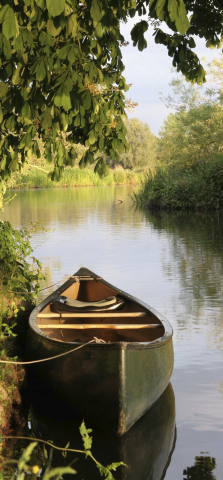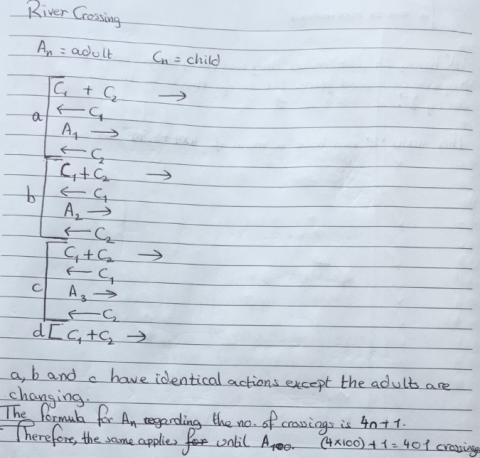River crossing
Problem
You may have met this introductory problem before, but have a think about it in preparation for tackling the main one that follows.
The fox, the hen and the corn

The farmer came to a river which needed to be crossed by boat. He could take only one of his purchases - the fox, or the hen, or the sack of corn - in the boat at a time.
Can you find a way for the farmer to get all of them across the river safely? (Note - only the farmer can row the boat!)
Can you find more than one way of getting them across with the minimum number of crossings?
There are two possible ways of getting them all across in seven crossings:
Hen & Farmer $\rightarrow$
$\leftarrow$ Farmer
Fox & Farmer $\rightarrow$
$\leftarrow$ Hen & Farmer
Corn & Farmer $\rightarrow$
$\leftarrow$ Farmer
Hen & Farmer $\rightarrow$
Hen & Farmer $\rightarrow$
$\leftarrow$ Farmer
Corn & Farmer $\rightarrow$
$\leftarrow$ Hen & Farmer
Fox & Farmer $\rightarrow$
$\leftarrow$ Farmer
Hen & Farmer $\rightarrow$
Adults and children
Two adults and two children need to cross a river in a rowing boat. Can you determine how to get everyone across, and how many crossings are needed, given the following information?
- All adults weigh the same
- Each child weighs half as much as an adult
- The boat can only carry the weight of one adult
- Adults and children can row the boat
- The boat must have someone in it to row it!
What if there were $3$ adults and $2$ children?
What if there were $100$ adults and $2$ children?
What if there were $n$ adults and $2$ children?
If you enjoyed these problems, you may also like to take a look at Crossing the Bridge.
With thanks to Don Steward, whose ideas formed the basis of this problem.

When you try to solve these 'river crossing' puzzles, you are attempting some of the same problems that were set by Alcuin, an ecclesiastic from the 9th century, for the Emperor Charlemagne.
Alcuin's version of Problem 1 concerned a wolf, a goat and a cabbage.
Getting Started
The fox, the hen and the corn
Who should the farmer take on the first trip out?
If the farmer takes the fox, the hen and corn will be left behind.
If the farmer takes the hen, the fox and corn will be left behind.
If the farmer takes the corn, the hen and fox will be left behind.
Adults and children
The first boat trip can either have one adult, one child, or two children in it, and someone will need to row the boat back.
The children will have to work harder than the adults!
Student Solutions
Well done to everyone who found a solution to the problem about the farmer, the fox, the hen and the chicken. Those solutions are not included here, because the solution to that section is inluded in the problem.
Kaylie and Zoe from Frederick Irwin Anglican School in Australia explained how to get two adults and two children across the river:
Kid 1=A
Kid 2=B
Adult 1=C
Adult 2=D
1. Send A and B over
2. Send A back
3. Send C over
4. Send B back
5. Send A and B over
6. Send B back
7. Send D over
8. Send A back
9. Send A and B over
Year 5 from Wellington College Shanghai in China, Ci Hui Minh Ngoc from Kelvin Grove State College (Brisbane) in Australia, Rohan from Wilson's School in the UK, Ari and George from Frederick Irwin Anglican School, Henry and Zach from Wilsthorpe School and Matt from JMG le Clézio in Vanuatu extended this idea to 3 adults and to 100 adults. This is Ari and George's work:
Solution for problem #2
There are three adults, A1, A2 and A3, and two children, K1 and K2.
1. K1 and K2 go to side B.
2. K1 goes back to side A but K2 stays at side B.
3. A1 goes to side B.
4. K2 goes back to side A.
5. K1 and K2 go to side B.
6. K1 goes back to side A but K2 stays at side B.
7. A2 goes to side B.
8. K2 goes back to side A.
9. K1 and K2 go to side B.
10. K1 goes back to side A but K2 stays at side B.
11. A3 goes to side B.
12. K2 goes back to side A.
13. Finally, K1 and K2 go to side B together.
Solution for problem #3
There are two sides of the river, side A and side B. We have one-hundred adults, A1, A2 and so on, and two children, K1 and K2.
1. K1 and K2 go to side B.
2. K2 goes back to side A
3. A1 goes to side B. There is now one adult and one kid at side B.
4. K1 goes back to side A.
5. Repeat 99 times.
6. Finally, the kids go over in the same boat.
There is a pattern that both children go over, one child comes back, an adult goes over, one child comes back. No matter how many adults there are, this pattern will always work.
Sunhari from British School Muscat in Oman, Nayanika from The Tiffin Girls' School in the UK and Elliott and Ben from Frederick Irwin Anglican School used a diagram and a formula to represent this pattern. This is Nayanika's work:

Elliott and Ben also wrote a Python script which uses the formula to work out how many trips are needed for any number of adults that the user inputs. You can see the script here. The script also offers the user options to see the problem, to see how the formula works and to see the full explanation on this website.
Teachers' Resources
The introductory problem is the classic river crossing problem.
Encourage students to consider the different options for the first boat trip.
There is only one possible safe choice for the initial crossing!
After that there is only one trip in which there is a choice.
The second problem can be taken further as it invites students to generalise to a larger, unknown number of adults. Students should be encouraged to work systematically so that the patterns in their results are easier to spot.
There is a simpler case (of one adult and two children) which is not mentioned in the problem.
